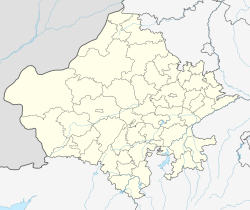Top Qs
Timeline
Chat
Perspective
Malasar
Village in the Bikaner District of Rajasthan State in India From Wikipedia, the free encyclopedia
Remove ads
Malasar (ⓘ) is a village located in Bikaner District in the Indian state of Rajasthan. This village is popular for its unique geographical location, beautiful sand dunes and sandy paths located in the heart of the Thar Desert.[4][5]
This article has multiple issues. Please help improve it or discuss these issues on the talk page. (Learn how and when to remove these messages)
|
As per the 2011 census of India, the total population of the village was 2,451 peoples, out of them 1,323 were males and 1,128 were females.[6]
Remove ads
Geography
The total geographic area of Malasar in 2011 was 4319 hectares. The village lies in the Lunkaransar assembly constituency and the Bikaner parliamentary constituency. The location (village) code of Malasar is 069063.[2]
Climate
Summarize
Perspective
The climate in Malasar is characterised by significant variations in temperature. In the summer season it is very hot when the temperatures lie in the range of 28 to 50 °C. In the winter, it is fairly cold with temperatures lying in the range of −4 to 23.2 °C. Annual rainfall is in the range of 260–440 millimetres. The highest ever temperature recorded is 49.5 °C on 19 May 2016 and lowest ever recorded is −4.0 °C on 26 January 1964.
Remove ads
Notable people
- Sumit Godara, Indian politician
Education
Malasar village has a rich educational history, with the Government Senior Secondary School in Malasar being a prominent institution since 1956. This school offers both Science and Arts streams, serving as the primary educational hub for students in the village. Additionally, there is the Government Girls Upper Primary School, which provides education to young girls in the area. For higher education, students from Malasar typically travel to nearby cities such as Bikaner and Jaipur, where they pursue various college and university courses to further their academic and professional aspirations.[11]
Remove ads
Agriculture
Summarize
Perspective
Agriculture is the main source of income of the village. More than 80 percent of the population here is directly or indirectly dependent on agriculture. In the traditional method of agriculture, crops are cultivated by camels pulling wooden or semi-wooden ploughs and the cultivation period is in July with plowing and harvesting in December–January. At present tractors and other equipment are widely used in farming. The main source of irrigation is rain water. At present tube-wells are becoming a popular source of irrigation. Due to availability of irrigation water throughout the year, many additional crops have also started being produced like cumin, Peanut, wheat, Mustard, isabgol and gram.
Guar
Guar is the main crop of the village and it generates a major part of the total agricultural income. It is the most suitable crop for village soil and requires less water than any other crop. In the village guar is used for selling in the market, boiling and feeding the cattle. After collecting and packing the guar seeds, the remaining dried stems of guar are used as cattle fodder, called Gwartaddi and kept in large stores for the cattle. Guar green leaves (Gwarfalli) can be used like spinach, and the pods are prepared like salad or vegetables
Bajri (Pearl Millet)
Bajri (Pearl Millet) is a traditional grain widely grown in arid regions, known for its versatility and nutritional value. It is typically cropped in the village when the monsoon arrives early, as it thrives in the rainfall conditions of the season. The primary use of bajri is in making flatbread, which is a staple in many households. It is also used as cattle feed, contributing to livestock nutrition. Additionally, bajri is often used to prepare dishes like khichda, a savory mix of grains and vegetables. It is considered to have better nutritional benefits compared to other grains, offering a good source of fiber, vitamins, and minerals. This grain is particularly preferred during the winter season due to its warming properties and ability to provide energy and strength.[12]
Moth
Moth is a traditional spice of Bikaner, known for its distinctive flavor and integral role in the region's cuisine. It is commonly used in various dishes such as dal, Bikaneri bhujia, papad, badi, and Bikaneri pakode, adding a unique taste that defines the local cuisine. Moth is considered to be very tasty and aromatic, contributing to the rich flavors of Bikaneri snacks. There is also a mysterious, almost secretive, role that moth plays in the success of Bikaneri namkeen (savory snacks), with its subtle yet crucial influence on the taste and texture of these beloved treats. Its use in local delicacies has helped Bikaner establish a reputation for its exceptional and distinct food culture.[13]
Remove ads
Demography
The population of Malasar, as recorded in the 2011 Census of India, stood at 3,500, with 1,798 males and 1,702 females. The village consists of around 400 families. The literacy rate in Malasar is reported to be 79%, with a positive trend in recent years. The primary occupations of the villagers include agriculture, self-employment, and jobs, including government service. In terms of caste distribution, 11% of the population belongs to the Scheduled Castes, 8% to the Scheduled Tribes, 70% to Other Backward Classes (OBC), and 11% to the General category. This demographic profile reflects the village’s diverse social structure and its reliance on agriculture and local employment.[2]
Remove ads
References
External links
Wikiwand - on
Seamless Wikipedia browsing. On steroids.
Remove ads






